
The Argentine Branch Library, sometimes known as the Argentine Carnegie Library was located at 2800 Metropolitan Avenue in Kansas City, Kansas. It was designed by Rose and Peterson (Architects). It was deemed as one of the KCK's historic landmarks on March 28, 1985. It was placed in the Register of Historic Kansas Places on November 23, 1985, and listed on the National Register of Historic Places on April 30, 1986.

The West Somerville Branch Library is a historic library at 40 College Avenue in Somerville, Massachusetts, just outside Davis Square. It is a fine local example of Classical Revival architecture, built in 1909 with funding support from Andrew Carnegie, and was the city's first branch library. It was listed on the National Register of Historic Places in 1989.
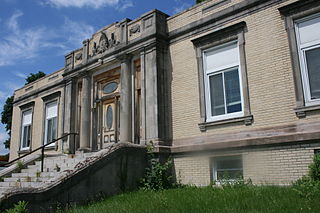
The South Worcester Branch Library is a historic former library building at 705 Southbridge Street in Worcester, Massachusetts. The single story Classical Revival building was built in 1913 by Henry D. Whitfield with funds donated by philanthropist Andrew Carnegie. The main facade consists of four windows, two on each side of a slightly projecting central entry pavilion. The building is set on a high basement, and granite stairs rise to the a doorway that is flanked by sidelights, then Doric pilasters, full height windows, and square cut columns with a center recessed section. The entry is topped by a decorative limestone panels. The walls are principally yellow brick, with limestone trim.
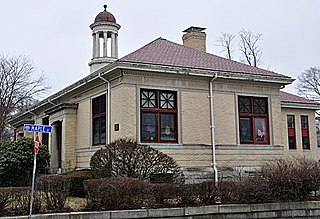
The Stoneham Public Library is the public library of Stoneham, Massachusetts. It is located at Main and Maple Streets.
George Putnam Washburn was a prominent architect practicing in Kansas. Washburn came to Kansas in 1870, worked as a carpenter and architect, and in 1882 opened an architecture practice in Ottawa, Kansas. His son joined his firm which became George P. Washburn & Son. In 1910 George P.'s son-in-law, Roy Stookey, joined the firm, and George P. retired. After George P. died in 1922 the firm became Washburn & Stookey.

The Burlington Carnegie Free Library is a Carnegie library located at 201 N. Third in Burlington, Kansas. The library was built in 1912 through a $9,656 grant from the Carnegie Foundation; it housed the city's library program, which was established in 1884. Architect George P. Washburn designed the library in a Classical Revival style with three bays, a design he used in several other libraries. The one-story brick library sits atop a limestone foundation. The front entrance is topped by a pediment; the main door has a large decorative glass transon and is topped by a limestone lintel.

The Manhattan Carnegie Library Building in Manhattan, Kansas, United States, is a Carnegie Library built in 1904. It was listed on the National Register of Historic Places in 1987.

The Wichita City Carnegie Library Building located at 220 S. Main Street in Wichita, Kansas, Sedgwick County, Kansas, United States, is a Carnegie library built in 1915. It was listed on the National Register of Historic Places in 1987. The two-story, limestone Beaux Arts building stands in the southwestern part of Wichita's central business district, directly south of the old City Hall. Its façade orientation is west. The building measures approximately one hundred and twenty-eight feet from north to south and eighty-three feet from east to west. After the completion of Wichita's present library in 1966, the Wichita City Carnegie Library Building served as city offices and the municipal court until the Wichita Omnisphere and Science Center established its tenancy in 1976, followed by changing tenants. The two-story, ashlar cut, limestone block building sits on an ashlar cut, limestone block, raised foundation with a multiply moulded watertable. Three bays comprise the rectangular building's façade and rear. The building's main body is one bay deep, a one-bay-by-one-bay brick unit extends from the rear elevation's center bay. A parapetted entry pavilion projects from the facade's center bay. A short, square tower rises from the building's central bay, covered by a rounded, truncated hipped roof sheathed with pantiles and surmounted by a monitor roof. Tripartite windows with translucent glass pierce each wall of the central tower. Standing seam metal covers the gable roofs of the two main wings, the metal may have been tarred. Two skylights, which have been covered due to water leakage, pierce the gable roofs midway. The entry pavilion and the rear extension have low roofs hidden by parapets, they are likely covered with tar and gravel. The building retains its original metal drain pipes on the outer edges of the façade and the rear extension.
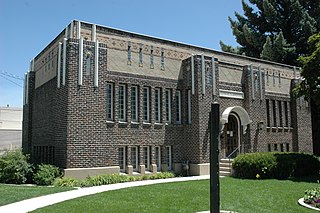
The Springville Carnegie Library at 175 South Main Street in Springville, Utah, United States is a Prairie School style Carnegie library building completed in 1922. It is one of the 23 Carnegie Libraries that were built in Utah. It functioned as the city public library until 1965, when the library was moved to a new larger building. The 1922 building was listed on the National Register of Historic Places in 1991. It now houses a pioneer relic museum for the Daughters of the Utah Pioneers.

The Cherryvale Carnegie Free Library is a Carnegie library located at 329 E. Main in Cherryvale, Kansas. The library was built in 1913 through a $10,000 grant from the Carnegie Foundation. Architect George P. Washburn, who also designed eight other Carnegie libraries in Kansas, designed the library in the Classical Revival style. The red brick library has three bays in its facade. The library's recessed entrance is a classical pavilion with a brick frieze and supporting Tuscan columns and brick pillars; the doorway is topped with a limestone lintel. The low roof of the library is surrounded by a parapet.

The Columbus Public Carnegie Library is a Carnegie library located at 205 N. Kansas in Columbus, Kansas. The library was built in 1913 through a $10,000 grant from the Carnegie foundation. George P. Washburn & Son designed the building in the Classical Revival style. The red brick building's facade is made up of three bays. The building's entrance pavilion features a wooden entablature reading "PUBLIC LIBRARY"; the entablature encircles the building. The doorway is topped by a glass transom with a triangular pattern and a limestone lintel.

The Eureka Carnegie Library is a Carnegie library located at 520 N. Main in Eureka, Kansas. The library was built in 1914 through a $9,000 grant from the Carnegie Foundation. The George P. Washburn Co. designed the building in the Classical Revival style. The red brick library has a facade with three bays. The library's main entrance is within a projecting pavilion topped by a keystone and two voussoirs; the doorway once had a transom which has since been covered. A limestone entablature encircles the building, and the windows feature brick lintels with limestone keystones.

The Sterling Free Public Carnegie Library is a Carnegie library located at 132 N. Broadway in Sterling, Kansas. The library was built in 1916 through a $10,000 grant from the Carnegie Foundation and housed Sterling's library association, which formed in 1902. Architect R. W. Stookey of George P. Washburn & Co. designed the library in the Jacobethan style. The one-story red brick building features a cross gable roof. The main entrance is in a projecting gabled pavilion; its doorway has a quoined limestone surround. The frieze over the doorway and a date tablet in the entrance's gable are also made of limestone.

The Fletcher Free Library is the public library serving Burlington, Vermont. It is located at 235 College Street, in an architecturally distinguished Beaux-Arts building, constructed in 1902 with funding support from philanthropist Andrew Carnegie. The building was listed on the National Register of Historic Places in 1976.

The Cadillac Carnegie Public Library, now the Wexford County Historical Society Museum, was constructed as a Carnegie Library located at 127 Beech Street in Cadillac, Michigan. It was designated a Michigan State Historic Site in 1980 and listed on the National Register of Historic Places in 2007.
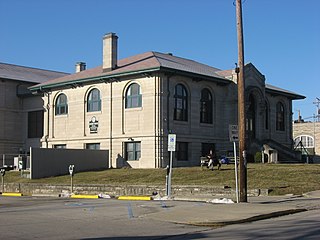
Monroe Carnegie Library, also known as Old Monroe Carnegie Library, is a historic Carnegie library located at Bloomington, Monroe County, Indiana. It was built in 1917, and is a one-story, rectangular, Neoclassical style limestone building on a raised basement. The Monroe County History Center is a history museum the historic library building that was established as a Carnegie library. The museum is located on the site of Center School in the former Bloomington Public Library building. The library building is now home to the Monroe County Historical Society, their collection of artifacts, and their Genealogy Library. A historical marker is present at the site. The History Center is located at 202 East 6th Street. It is a tourist attraction.
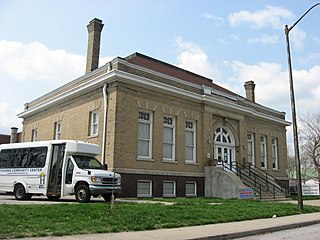
Hawthorne Branch Library No. 2, also known as Hawthorne Education Annex, is a historic Carnegie library building located in Indianapolis, Marion County, Indiana. Built in 1909-1911, with funds provided by the Carnegie Foundation, it is a one-story, rectangular, Classical Revival style brick and limestone building on a raised basement. It has a truncated hipped roof and features a slightly projecting pavilion housing a round arch. It was renovated in 1955, after its closure as a library, and again in 1999.

Bolivar Public Library, also known as the Carnegie Library of Bolivar and Polk County Genealogical Society Library, is a historic Carnegie library located at Bolivar, Polk County, Missouri. It was built in 1915, and is a 1 1/2- to two-story, rectangular, brick building with Classical Revival style design elements. It has a flat roof and three bay front facade with an elaborate center entranceway and large side window bays. It features intact terra cotta and tooled limestone ornamentation. It was funded by an $8,000 Carnegie grant from the Carnegie Foundation. The property was listed on the National Register of Historic Places in 2003.

The Yates Center Carnegie Library, located at 218 N. Main in Yates Center in Woodson County, Kansas, is a Carnegie library which was built in about 1912. It was listed on the National Register of Historic Places in 1987.

The Lyndon Carnegie Library, located at 127 E. Sixth in Lyndon, Kansas, is a Classical Revival-style Carnegie library which was built in about 1911. It was listed on the National Register of Historic Places in 1987.























